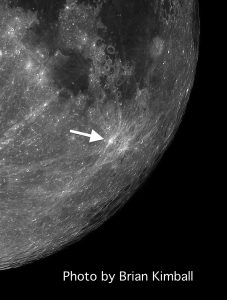 The week of May 30 – June 5 takes us from the end of lunar Day 23 to the beginning of Day 1. Moon observers will have to be unusually dedicated as the Moon does not rise until 2:00 AM on Monday. This week we will highlight the crater Furnerius A.
The week of May 30 – June 5 takes us from the end of lunar Day 23 to the beginning of Day 1. Moon observers will have to be unusually dedicated as the Moon does not rise until 2:00 AM on Monday. This week we will highlight the crater Furnerius A.
 Furnerius A: [SE/N15] Furnerius A is only 7 miles in diameter but produces a ray that extends for 1,200 miles! How is it that such a tiny crater can splash its debris over nearly half of the Moon’s surface! On Monday night the entire length of the ray should be clearly visible. (If you have Sky & Telescope’s Field Map of the Moon, look closely for the tiny arrow that points out Furnerius A; it’s easy to miss.)
Furnerius A: [SE/N15] Furnerius A is only 7 miles in diameter but produces a ray that extends for 1,200 miles! How is it that such a tiny crater can splash its debris over nearly half of the Moon’s surface! On Monday night the entire length of the ray should be clearly visible. (If you have Sky & Telescope’s Field Map of the Moon, look closely for the tiny arrow that points out Furnerius A; it’s easy to miss.)
OF ADDITIONAL INTEREST ON LUNAR DAY 23 TO THE BEGINNING OF DAY 1:
Although Mars reached opposition on Sunday, May 22nd, it will actually be closer (and slightly larger) this Monday, May 30th, when it is the closest to the Earth that it will be for the next two years. During the next few weeks Mars will have a prime viewing window, so take advantage of this opportunity.
For a great program to see what features are visible on Mars for any date and time go to:
http://www.skyandtelescope.com/observing/interactive-sky-watching-tools/
Several extremely valuable tools are provided on this page by Sky and Telescope. Click away on the ones that interest you.
Jupiter is well-positioned in Leo for evening observing through July. On Monday at 10:30 PM EDT the Great Red Spot will be visible on the South Equatorial Belt and will remain visible for three hours.
Saturn rises at 8:00 PM local time and forms a right triangle with Mars and the star Antares. This is a good opportunity to see why Antares (meaning “the rival of Mars”) was so named because its red color caused it to be confused with the red planet. (When Mars isn’t so bright, the similarity is even more obvious.)
======================
It is highly recommended that you get a copy of Sky and Telescope’s Field Map of the Moon, the very finest Moon map available for use at the telescope. It is available for $10.95 at www.skyandtelescope.com and on Amazon. All features mentioned in this blog will be keyed to the grid on the Field Map and will look like this: Plato: [NW/D9]
Credits:
Courtesy of Gray Photography of Corpus Christi, Texas
Lunar photos: NASA / USGS / BMDO / LROC / ASU / DLR / LOLA / Moon Globe. Used by permission
- Rupes Cauchy: A Best Known Fault on the Moon - July 22, 2024
- Moon Crater Schickard – Crater Floor has Stripes - July 15, 2024
- Moon Craters Langrenus and Vandelinus - July 8, 2024